International Business Report: ChAFTA and Australia's Trade Agreements
VerifiedAdded on 2020/05/28
|7
|1708
|105
Report
AI Summary
This report provides an analysis of free trade agreements and their impact on international trade, focusing on Australia's trade relationships. It specifically examines the China-Australia Free Trade Agreement (ChAFTA), highlighting its background, implementation, and key outcomes. The report discusses the reduction of tariffs on various goods, including agricultural products, energy resources, and manufactured items. It also outlines the opportunities and potential threats associated with ChAFTA, such as increased access to the Chinese market and investor rights. The paper reviews the agreement's progress, advantages for Australian exporters, and the overall economic benefits for Australia, while also addressing critical concerns related to the treaty-making process and potential impacts on various sectors. The report concludes by emphasizing the importance of considering both the advantages and disadvantages of such trade agreements for the country's economic development.
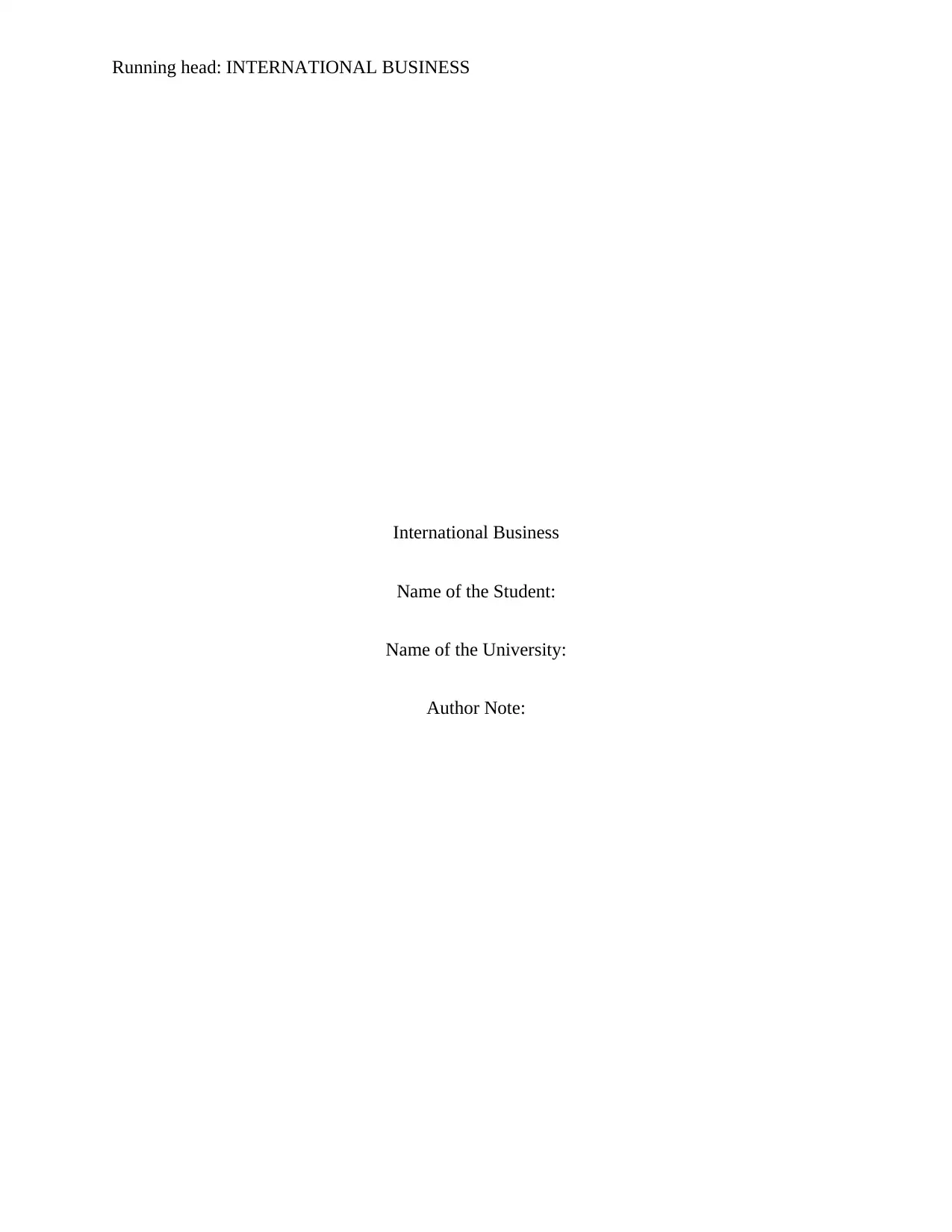
Running head: INTERNATIONAL BUSINESS
International Business
Name of the Student:
Name of the University:
Author Note:
International Business
Name of the Student:
Name of the University:
Author Note:
Paraphrase This Document
Need a fresh take? Get an instant paraphrase of this document with our AI Paraphraser
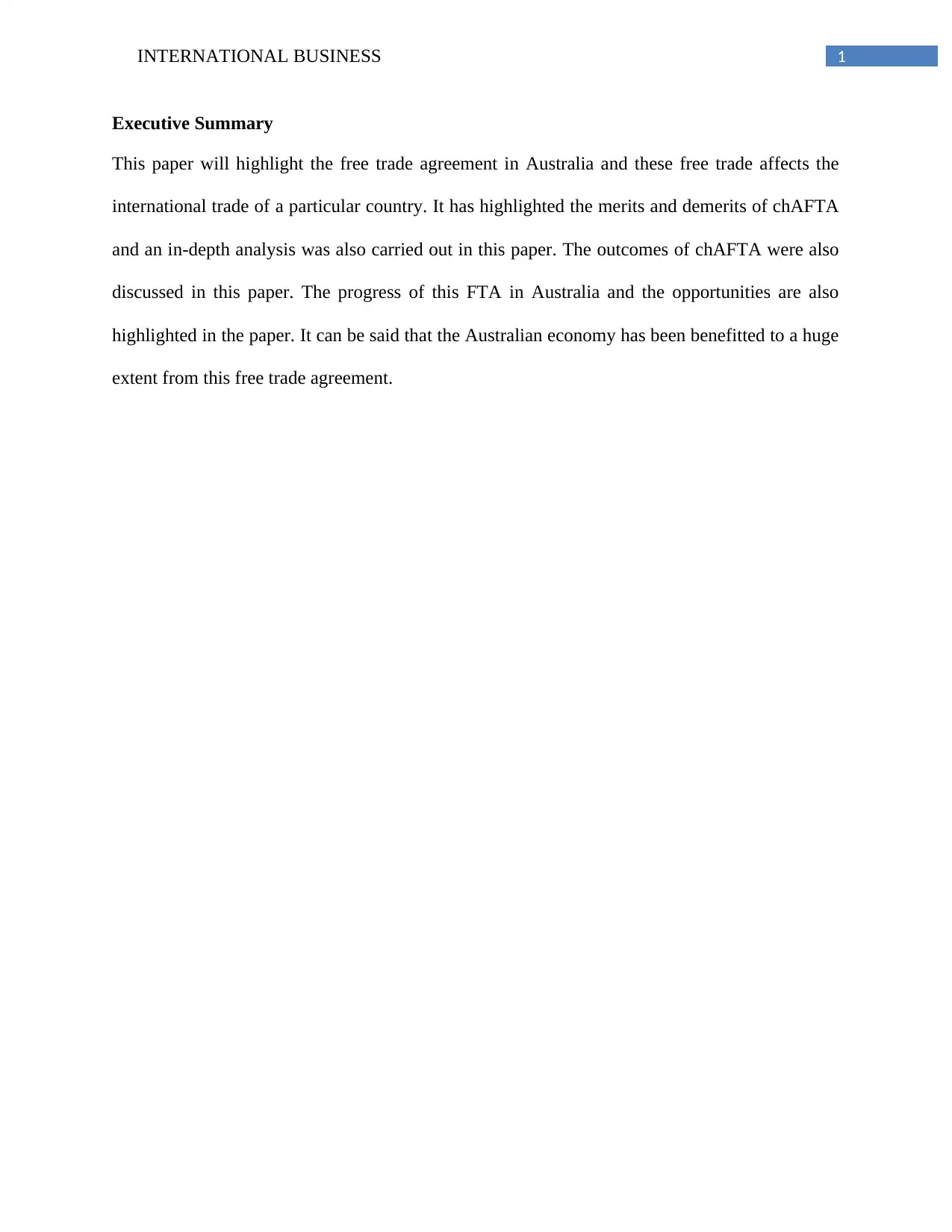
1INTERNATIONAL BUSINESS
Executive Summary
This paper will highlight the free trade agreement in Australia and these free trade affects the
international trade of a particular country. It has highlighted the merits and demerits of chAFTA
and an in-depth analysis was also carried out in this paper. The outcomes of chAFTA were also
discussed in this paper. The progress of this FTA in Australia and the opportunities are also
highlighted in the paper. It can be said that the Australian economy has been benefitted to a huge
extent from this free trade agreement.
Executive Summary
This paper will highlight the free trade agreement in Australia and these free trade affects the
international trade of a particular country. It has highlighted the merits and demerits of chAFTA
and an in-depth analysis was also carried out in this paper. The outcomes of chAFTA were also
discussed in this paper. The progress of this FTA in Australia and the opportunities are also
highlighted in the paper. It can be said that the Australian economy has been benefitted to a huge
extent from this free trade agreement.
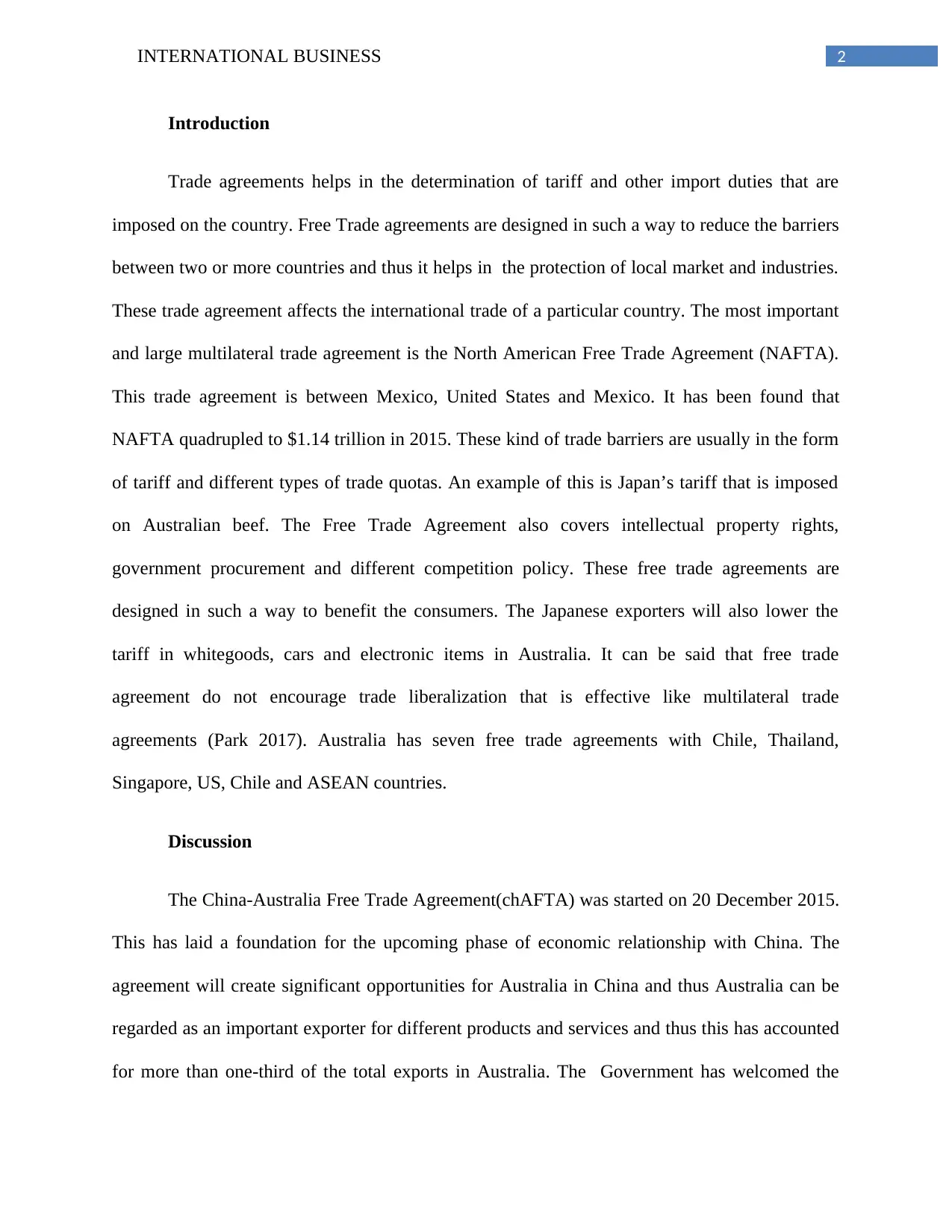
2INTERNATIONAL BUSINESS
Introduction
Trade agreements helps in the determination of tariff and other import duties that are
imposed on the country. Free Trade agreements are designed in such a way to reduce the barriers
between two or more countries and thus it helps in the protection of local market and industries.
These trade agreement affects the international trade of a particular country. The most important
and large multilateral trade agreement is the North American Free Trade Agreement (NAFTA).
This trade agreement is between Mexico, United States and Mexico. It has been found that
NAFTA quadrupled to $1.14 trillion in 2015. These kind of trade barriers are usually in the form
of tariff and different types of trade quotas. An example of this is Japan’s tariff that is imposed
on Australian beef. The Free Trade Agreement also covers intellectual property rights,
government procurement and different competition policy. These free trade agreements are
designed in such a way to benefit the consumers. The Japanese exporters will also lower the
tariff in whitegoods, cars and electronic items in Australia. It can be said that free trade
agreement do not encourage trade liberalization that is effective like multilateral trade
agreements (Park 2017). Australia has seven free trade agreements with Chile, Thailand,
Singapore, US, Chile and ASEAN countries.
Discussion
The China-Australia Free Trade Agreement(chAFTA) was started on 20 December 2015.
This has laid a foundation for the upcoming phase of economic relationship with China. The
agreement will create significant opportunities for Australia in China and thus Australia can be
regarded as an important exporter for different products and services and thus this has accounted
for more than one-third of the total exports in Australia. The Government has welcomed the
Introduction
Trade agreements helps in the determination of tariff and other import duties that are
imposed on the country. Free Trade agreements are designed in such a way to reduce the barriers
between two or more countries and thus it helps in the protection of local market and industries.
These trade agreement affects the international trade of a particular country. The most important
and large multilateral trade agreement is the North American Free Trade Agreement (NAFTA).
This trade agreement is between Mexico, United States and Mexico. It has been found that
NAFTA quadrupled to $1.14 trillion in 2015. These kind of trade barriers are usually in the form
of tariff and different types of trade quotas. An example of this is Japan’s tariff that is imposed
on Australian beef. The Free Trade Agreement also covers intellectual property rights,
government procurement and different competition policy. These free trade agreements are
designed in such a way to benefit the consumers. The Japanese exporters will also lower the
tariff in whitegoods, cars and electronic items in Australia. It can be said that free trade
agreement do not encourage trade liberalization that is effective like multilateral trade
agreements (Park 2017). Australia has seven free trade agreements with Chile, Thailand,
Singapore, US, Chile and ASEAN countries.
Discussion
The China-Australia Free Trade Agreement(chAFTA) was started on 20 December 2015.
This has laid a foundation for the upcoming phase of economic relationship with China. The
agreement will create significant opportunities for Australia in China and thus Australia can be
regarded as an important exporter for different products and services and thus this has accounted
for more than one-third of the total exports in Australia. The Government has welcomed the
⊘ This is a preview!⊘
Do you want full access?
Subscribe today to unlock all pages.

Trusted by 1+ million students worldwide

3INTERNATIONAL BUSINESS
final recommendation of the Committee to take further treaty actions that needs to be taken in
relation to chAFTA (Zhou and Zhang 2016). Australia has completed this domestic treaty and
thus there has been exchange of notes with China on 9th December, 2015. The Committee of
chAFTA has recommended that the government agencies and departments are the responsible
agents for curbing unlawful activities that is associated with the Department of Immigration and
Border Protection and thus it closely monitors the compliance that is associated with visas to the
temporary workers in China.
More than 96% of Australia’s goods comes from chAFTA and China is eligible to enter
the country with duty free tax or preferential agreement. Moreover, China also buys a majority
produce of Australian goods and in 2016, it has been found that this has worth more than $10
billion to the Australian farmers. It can be said that chAFTA is advantageous for the agricultural
farmers of Australia and the other competitors such as Canada, United States and European
Union (dfat.gov.au 2018). The country has also encountered advantages over New Zealand and
Chile and thus it is also enjoying FTA with China. It can be said that in the field of agriculture,
chAFTA has eliminated tariffs on sorghum and barley that is produced in Australia and thus this
has led to rapid trade reduction in the country. The tariff rate on dairy products will be lowered
by 20% by 1st January 2026. On the other hand, tariff reduction in beef will be lowered by 12 to
25% and this will be effective by January, 2024. Moreover, the tariff rate in wine will be lowered
by 14 to 20% by January 2019. In relation to the continuous access of China’s wool quota, it can
be said that chAFTA has also brought a duty free quota on Australia’s wool (dfat.gov.au 2018).
China is also regarded as the largest exporter for energy and other resource products.
Australia has exported more than $74 billion worth of energy, resources and manufactured
products to China. By December 2015, more than 92.8% of the imports of China has entered
final recommendation of the Committee to take further treaty actions that needs to be taken in
relation to chAFTA (Zhou and Zhang 2016). Australia has completed this domestic treaty and
thus there has been exchange of notes with China on 9th December, 2015. The Committee of
chAFTA has recommended that the government agencies and departments are the responsible
agents for curbing unlawful activities that is associated with the Department of Immigration and
Border Protection and thus it closely monitors the compliance that is associated with visas to the
temporary workers in China.
More than 96% of Australia’s goods comes from chAFTA and China is eligible to enter
the country with duty free tax or preferential agreement. Moreover, China also buys a majority
produce of Australian goods and in 2016, it has been found that this has worth more than $10
billion to the Australian farmers. It can be said that chAFTA is advantageous for the agricultural
farmers of Australia and the other competitors such as Canada, United States and European
Union (dfat.gov.au 2018). The country has also encountered advantages over New Zealand and
Chile and thus it is also enjoying FTA with China. It can be said that in the field of agriculture,
chAFTA has eliminated tariffs on sorghum and barley that is produced in Australia and thus this
has led to rapid trade reduction in the country. The tariff rate on dairy products will be lowered
by 20% by 1st January 2026. On the other hand, tariff reduction in beef will be lowered by 12 to
25% and this will be effective by January, 2024. Moreover, the tariff rate in wine will be lowered
by 14 to 20% by January 2019. In relation to the continuous access of China’s wool quota, it can
be said that chAFTA has also brought a duty free quota on Australia’s wool (dfat.gov.au 2018).
China is also regarded as the largest exporter for energy and other resource products.
Australia has exported more than $74 billion worth of energy, resources and manufactured
products to China. By December 2015, more than 92.8% of the imports of China has entered
Paraphrase This Document
Need a fresh take? Get an instant paraphrase of this document with our AI Paraphraser
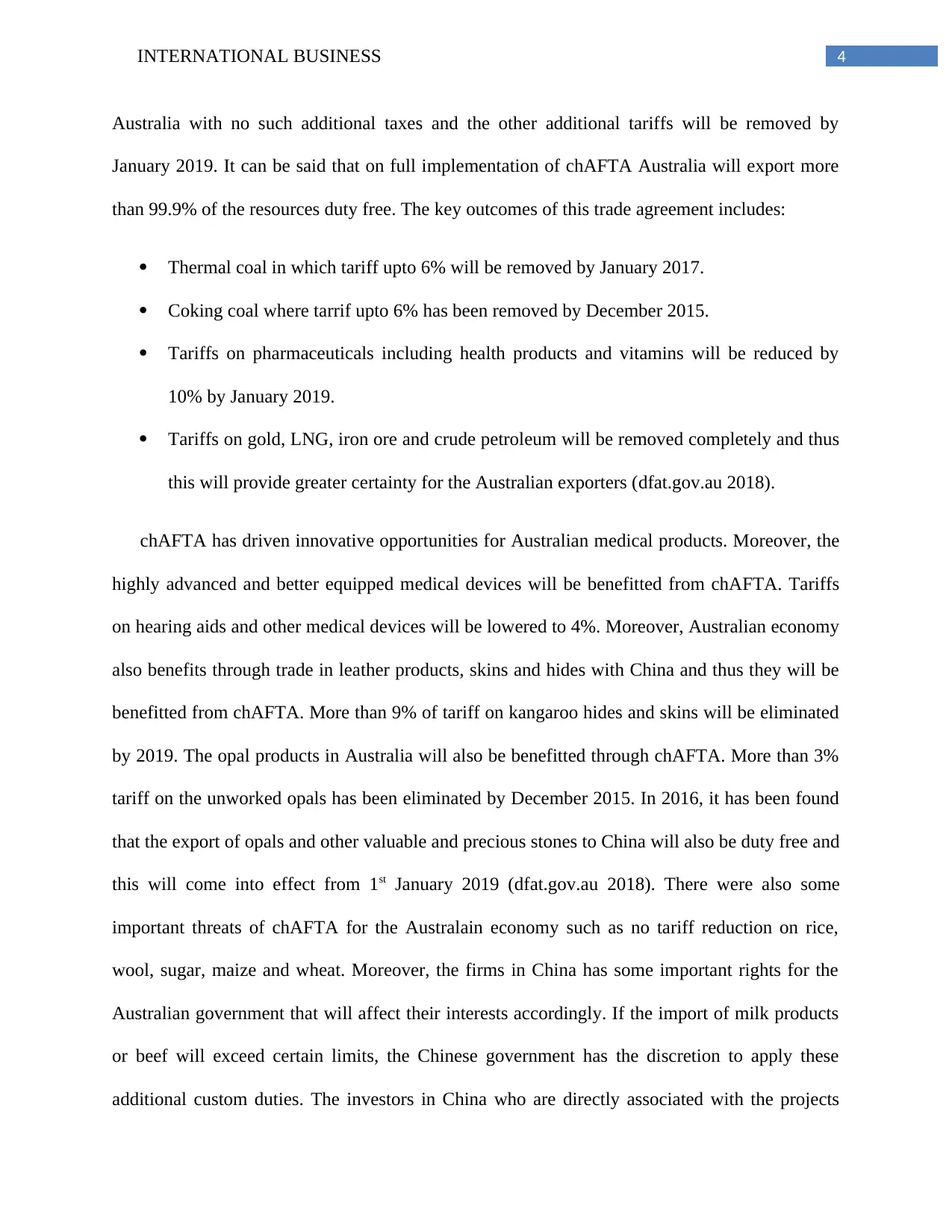
4INTERNATIONAL BUSINESS
Australia with no such additional taxes and the other additional tariffs will be removed by
January 2019. It can be said that on full implementation of chAFTA Australia will export more
than 99.9% of the resources duty free. The key outcomes of this trade agreement includes:
Thermal coal in which tariff upto 6% will be removed by January 2017.
Coking coal where tarrif upto 6% has been removed by December 2015.
Tariffs on pharmaceuticals including health products and vitamins will be reduced by
10% by January 2019.
Tariffs on gold, LNG, iron ore and crude petroleum will be removed completely and thus
this will provide greater certainty for the Australian exporters (dfat.gov.au 2018).
chAFTA has driven innovative opportunities for Australian medical products. Moreover, the
highly advanced and better equipped medical devices will be benefitted from chAFTA. Tariffs
on hearing aids and other medical devices will be lowered to 4%. Moreover, Australian economy
also benefits through trade in leather products, skins and hides with China and thus they will be
benefitted from chAFTA. More than 9% of tariff on kangaroo hides and skins will be eliminated
by 2019. The opal products in Australia will also be benefitted through chAFTA. More than 3%
tariff on the unworked opals has been eliminated by December 2015. In 2016, it has been found
that the export of opals and other valuable and precious stones to China will also be duty free and
this will come into effect from 1st January 2019 (dfat.gov.au 2018). There were also some
important threats of chAFTA for the Australain economy such as no tariff reduction on rice,
wool, sugar, maize and wheat. Moreover, the firms in China has some important rights for the
Australian government that will affect their interests accordingly. If the import of milk products
or beef will exceed certain limits, the Chinese government has the discretion to apply these
additional custom duties. The investors in China who are directly associated with the projects
Australia with no such additional taxes and the other additional tariffs will be removed by
January 2019. It can be said that on full implementation of chAFTA Australia will export more
than 99.9% of the resources duty free. The key outcomes of this trade agreement includes:
Thermal coal in which tariff upto 6% will be removed by January 2017.
Coking coal where tarrif upto 6% has been removed by December 2015.
Tariffs on pharmaceuticals including health products and vitamins will be reduced by
10% by January 2019.
Tariffs on gold, LNG, iron ore and crude petroleum will be removed completely and thus
this will provide greater certainty for the Australian exporters (dfat.gov.au 2018).
chAFTA has driven innovative opportunities for Australian medical products. Moreover, the
highly advanced and better equipped medical devices will be benefitted from chAFTA. Tariffs
on hearing aids and other medical devices will be lowered to 4%. Moreover, Australian economy
also benefits through trade in leather products, skins and hides with China and thus they will be
benefitted from chAFTA. More than 9% of tariff on kangaroo hides and skins will be eliminated
by 2019. The opal products in Australia will also be benefitted through chAFTA. More than 3%
tariff on the unworked opals has been eliminated by December 2015. In 2016, it has been found
that the export of opals and other valuable and precious stones to China will also be duty free and
this will come into effect from 1st January 2019 (dfat.gov.au 2018). There were also some
important threats of chAFTA for the Australain economy such as no tariff reduction on rice,
wool, sugar, maize and wheat. Moreover, the firms in China has some important rights for the
Australian government that will affect their interests accordingly. If the import of milk products
or beef will exceed certain limits, the Chinese government has the discretion to apply these
additional custom duties. The investors in China who are directly associated with the projects
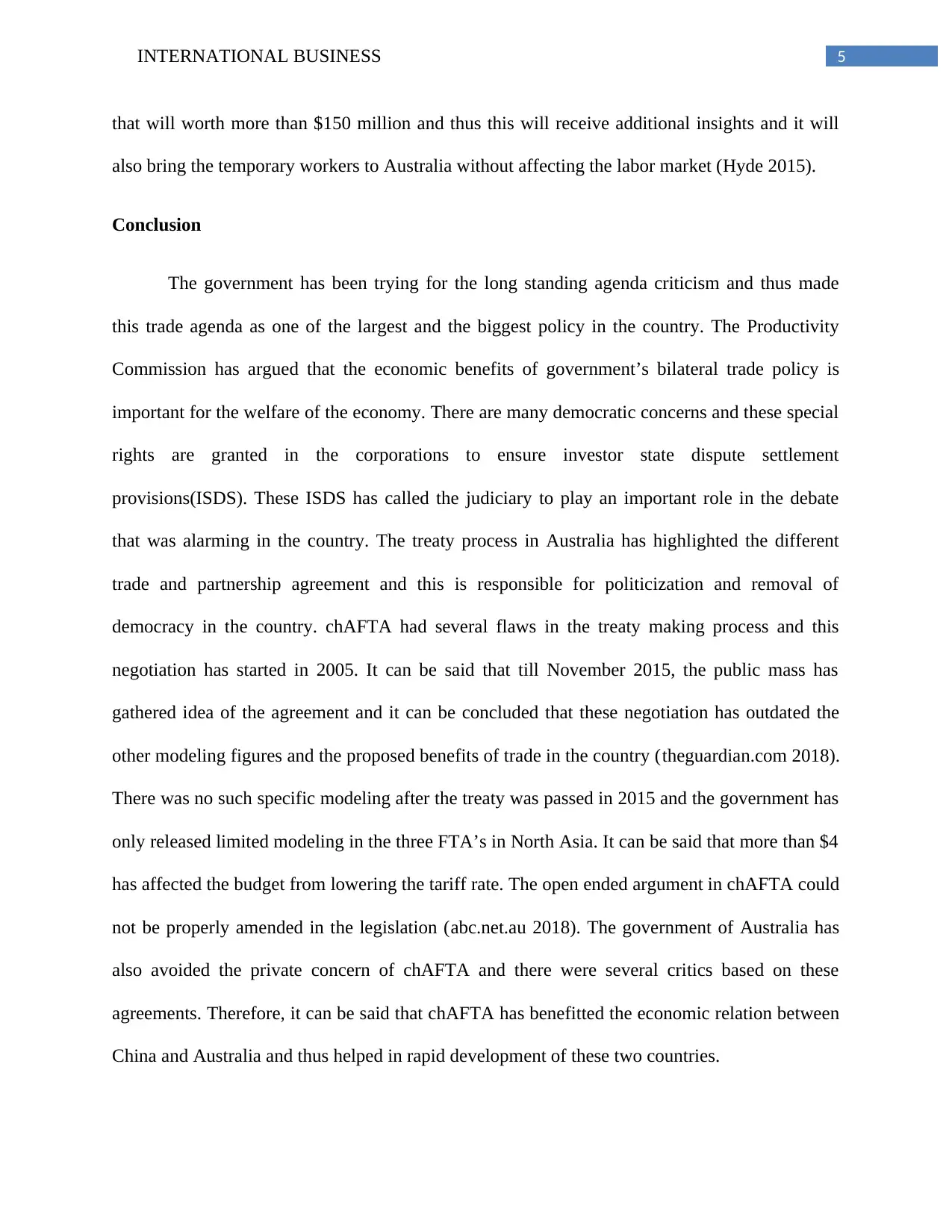
5INTERNATIONAL BUSINESS
that will worth more than $150 million and thus this will receive additional insights and it will
also bring the temporary workers to Australia without affecting the labor market (Hyde 2015).
Conclusion
The government has been trying for the long standing agenda criticism and thus made
this trade agenda as one of the largest and the biggest policy in the country. The Productivity
Commission has argued that the economic benefits of government’s bilateral trade policy is
important for the welfare of the economy. There are many democratic concerns and these special
rights are granted in the corporations to ensure investor state dispute settlement
provisions(ISDS). These ISDS has called the judiciary to play an important role in the debate
that was alarming in the country. The treaty process in Australia has highlighted the different
trade and partnership agreement and this is responsible for politicization and removal of
democracy in the country. chAFTA had several flaws in the treaty making process and this
negotiation has started in 2005. It can be said that till November 2015, the public mass has
gathered idea of the agreement and it can be concluded that these negotiation has outdated the
other modeling figures and the proposed benefits of trade in the country (theguardian.com 2018).
There was no such specific modeling after the treaty was passed in 2015 and the government has
only released limited modeling in the three FTA’s in North Asia. It can be said that more than $4
has affected the budget from lowering the tariff rate. The open ended argument in chAFTA could
not be properly amended in the legislation (abc.net.au 2018). The government of Australia has
also avoided the private concern of chAFTA and there were several critics based on these
agreements. Therefore, it can be said that chAFTA has benefitted the economic relation between
China and Australia and thus helped in rapid development of these two countries.
that will worth more than $150 million and thus this will receive additional insights and it will
also bring the temporary workers to Australia without affecting the labor market (Hyde 2015).
Conclusion
The government has been trying for the long standing agenda criticism and thus made
this trade agenda as one of the largest and the biggest policy in the country. The Productivity
Commission has argued that the economic benefits of government’s bilateral trade policy is
important for the welfare of the economy. There are many democratic concerns and these special
rights are granted in the corporations to ensure investor state dispute settlement
provisions(ISDS). These ISDS has called the judiciary to play an important role in the debate
that was alarming in the country. The treaty process in Australia has highlighted the different
trade and partnership agreement and this is responsible for politicization and removal of
democracy in the country. chAFTA had several flaws in the treaty making process and this
negotiation has started in 2005. It can be said that till November 2015, the public mass has
gathered idea of the agreement and it can be concluded that these negotiation has outdated the
other modeling figures and the proposed benefits of trade in the country (theguardian.com 2018).
There was no such specific modeling after the treaty was passed in 2015 and the government has
only released limited modeling in the three FTA’s in North Asia. It can be said that more than $4
has affected the budget from lowering the tariff rate. The open ended argument in chAFTA could
not be properly amended in the legislation (abc.net.au 2018). The government of Australia has
also avoided the private concern of chAFTA and there were several critics based on these
agreements. Therefore, it can be said that chAFTA has benefitted the economic relation between
China and Australia and thus helped in rapid development of these two countries.
⊘ This is a preview!⊘
Do you want full access?
Subscribe today to unlock all pages.

Trusted by 1+ million students worldwide
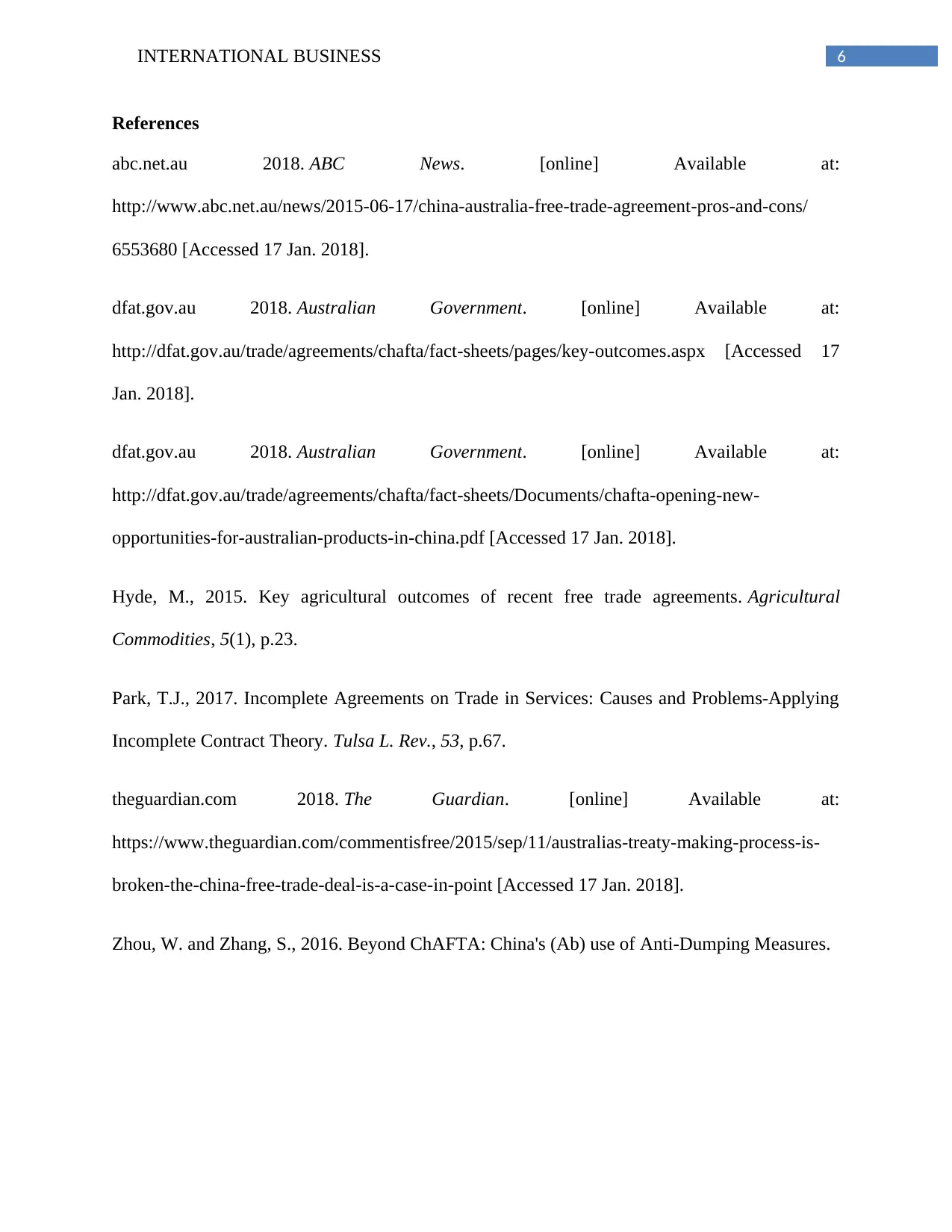
6INTERNATIONAL BUSINESS
References
abc.net.au 2018. ABC News. [online] Available at:
http://www.abc.net.au/news/2015-06-17/china-australia-free-trade-agreement-pros-and-cons/
6553680 [Accessed 17 Jan. 2018].
dfat.gov.au 2018. Australian Government. [online] Available at:
http://dfat.gov.au/trade/agreements/chafta/fact-sheets/pages/key-outcomes.aspx [Accessed 17
Jan. 2018].
dfat.gov.au 2018. Australian Government. [online] Available at:
http://dfat.gov.au/trade/agreements/chafta/fact-sheets/Documents/chafta-opening-new-
opportunities-for-australian-products-in-china.pdf [Accessed 17 Jan. 2018].
Hyde, M., 2015. Key agricultural outcomes of recent free trade agreements. Agricultural
Commodities, 5(1), p.23.
Park, T.J., 2017. Incomplete Agreements on Trade in Services: Causes and Problems-Applying
Incomplete Contract Theory. Tulsa L. Rev., 53, p.67.
theguardian.com 2018. The Guardian. [online] Available at:
https://www.theguardian.com/commentisfree/2015/sep/11/australias-treaty-making-process-is-
broken-the-china-free-trade-deal-is-a-case-in-point [Accessed 17 Jan. 2018].
Zhou, W. and Zhang, S., 2016. Beyond ChAFTA: China's (Ab) use of Anti-Dumping Measures.
References
abc.net.au 2018. ABC News. [online] Available at:
http://www.abc.net.au/news/2015-06-17/china-australia-free-trade-agreement-pros-and-cons/
6553680 [Accessed 17 Jan. 2018].
dfat.gov.au 2018. Australian Government. [online] Available at:
http://dfat.gov.au/trade/agreements/chafta/fact-sheets/pages/key-outcomes.aspx [Accessed 17
Jan. 2018].
dfat.gov.au 2018. Australian Government. [online] Available at:
http://dfat.gov.au/trade/agreements/chafta/fact-sheets/Documents/chafta-opening-new-
opportunities-for-australian-products-in-china.pdf [Accessed 17 Jan. 2018].
Hyde, M., 2015. Key agricultural outcomes of recent free trade agreements. Agricultural
Commodities, 5(1), p.23.
Park, T.J., 2017. Incomplete Agreements on Trade in Services: Causes and Problems-Applying
Incomplete Contract Theory. Tulsa L. Rev., 53, p.67.
theguardian.com 2018. The Guardian. [online] Available at:
https://www.theguardian.com/commentisfree/2015/sep/11/australias-treaty-making-process-is-
broken-the-china-free-trade-deal-is-a-case-in-point [Accessed 17 Jan. 2018].
Zhou, W. and Zhang, S., 2016. Beyond ChAFTA: China's (Ab) use of Anti-Dumping Measures.
1 out of 7
Related Documents
Your All-in-One AI-Powered Toolkit for Academic Success.
+13062052269
info@desklib.com
Available 24*7 on WhatsApp / Email
![[object Object]](/_next/static/media/star-bottom.7253800d.svg)
Unlock your academic potential
Copyright © 2020–2025 A2Z Services. All Rights Reserved. Developed and managed by ZUCOL.





